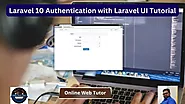-
About
- About Listly
- Community & Support
- Howto
- Chrome Extension
- Bookmarklet
- WordPress Plugin
- Listly Premium
- Privacy
- Terms
- DMCA Copyright
- © 2010-2025 Boomy Labs

Listly by Neeraj Kumar
Laravel tutorials, Best Place to Learn Laravel. Laravel Advance Articles on Installation, Payment Gateway, Stubs, Push Notifications, jQuery Notifications, AJAX Request, Livewire, Authentication Methods etc. Step by Step Laravel Tutorials.

Authentication is an essential part of every web site, ensuring that users have a safe and personalised experience. We will walk you through the process of creating authentication in Laravel 10 using Laravel UI in this article.
Laravel UI is a powerful package that simplifies authentication setup, allowing you to add user registration, login, and password reset functionality into your Laravel 10 applications quickly.
https://onlinewebtutorblog.com/laravel-10-authentication-with-laravel-ui-tutorial/

Managing dependencies is an important component of modern web development with Laravel 10, and Composer plays an important role in handling package installations. However, as your project progresses, you may discover that certain Composer packages are no longer required or have become obsolete.
This tutorial will walk you through the process of deleting a Composer package from your Laravel 10 project step by step.
https://onlinewebtutorblog.com/laravel-10-remove-composer-package-tutorial/

Custom validation rules in Laravel 10 provide a powerful approach to validate incoming data depending on your individual application requirements. While Laravel has a number of built-in validation rules, there may be times when you need to construct your own custom validation rules to deal with unusual data validation cases.

Caching is an important approach in web development for improving application performance and reducing database load. Caching data in Laravel 10 lets you to keep frequently visited or computationally expensive data in memory, allowing for faster retrieval and response times for subsequent queries.
https://onlinewebtutorblog.com/store-data-in-cache-in-laravel-10-tutorial/

Seeders are required in Laravel 10 to populate the database with initial or test data. While executing all seeders to populate the whole database is a usual strategy, there may be times when you want to execute a certain seeder separately.
https://onlinewebtutorblog.com/run-specific-seeder-in-laravel-10/

In this lesson, we’ll walk you through the steps of uploading an XML file, parsing its data, and saving it to the database in Laravel 10. We’ll look at the tools and strategies for working with XML files, extracting useful information, and storing it in a database with Laravel’s Eloquent ORM.
https://onlinewebtutorblog.com/laravel-10-upload-and-save-xml-file-data-in-database/

Push notifications on iOS devices via Firebase Cloud Messaging (FCM) are a great way to keep your users engaged and give real-time updates to your iOS application in Laravel 10. Google Firebase Cloud Messaging is a free and dependable messaging service that allows you to deliver notifications to Android, iOS, and web users.
https://onlinewebtutorblog.com/laravel-send-push-notification-to-ios-using-firebase/

Making HTTP POST requests using cURL and custom headers in Laravel 10 provides a reliable approach to exchange data with other APIs, services, or endpoints. The cURL library sends and receives data via the HTTP protocol, making it a useful tool for integrating and communicating with various web services.
https://onlinewebtutorblog.com/laravel-10-http-curl-post-request-with-headers-tutorial/

Pagination is a necessary function for showing vast amounts of data in an understandable manner. Using Laravel 10 and the renowned Bootstrap framework, you can design visually beautiful and responsive pagination controls for your web application.
https://onlinewebtutorblog.com/laravel-10-pagination-with-bootstrap/

This tutorial will walk you through the steps of redirecting routes with query string arguments in Laravel 10. We’ll look at how to create URLs with query string arguments, how to traverse between routes with the redirect() method, and how to properly transmit data between different portions of your application.
https://onlinewebtutorblog.com/laravel-10-redirect-route-with-query-string-parameters/

In this article, we will walk you through the process of configuring Ajax requests in Laravel 10. We’ll look at how to use JavaScript and jQuery to create asynchronous requests to your backend, deliver data, and handle responses in real time.
https://onlinewebtutorblog.com/laravel-10-how-to-setup-ajax-request/

Using the power of database relationships is critical in Laravel 10 for building powerful and efficient apps. The INNER JOIN is a key concept in relational databases that allows you to integrate data from several tables based on matching values in defined fields.
https://onlinewebtutorblog.com/laravel-10-mysql-inner-join/

Laravel 10 provides developers with a comprehensive framework for interacting with MySQL databases and extracting valuable insights. Among the SQL operations available, the RIGHT JOIN stands out as a powerful tool for combining data from two tables, including unmatched records from the right table.
https://onlinewebtutorblog.com/laravel-10-mysql-right-join/

Interacting with JSON (JavaScript Object Notation) data has become an essential aspect of constructing dynamic and data-driven applications in the present era of web development. Laravel 10, a sophisticated PHP framework, gives developers the tools they need to read and handle JSON files, allowing them to take advantage of the richness of JSON data in their applications.

UUIDs (Universally Unique Identifiers) have become an essential component of modern web applications, providing a dependable and globally unique method of identifying records in databases.
Generating UUIDs in Laravel 10 provides a solid method for preventing potential conflicts and preserving data integrity, particularly when working in distant and interconnected systems.
https://onlinewebtutorblog.com/laravel-10-how-to-generate-uuid/

It is vital to populate your database with realistic and diverse data when designing and testing online apps. The Faker module appears as a powerful feature in Laravel 10 that allows you to construct fake data with precision and ease. This data seeding procedure not only saves time but also ensures that the database of your application is populated with representative data for testing and development.
https://onlinewebtutorblog.com/laravel-10-seed-database-using-faker/

Session management is a critical component of online application development, as it ensures security, user experience, and resource optimisation. In Laravel 10, determining how long user sessions remain active and accessible is critical for balancing security and user comfort.
https://onlinewebtutorblog.com/laravel-10-handle-session-timeout/

This tutorial will walk you through the steps of creating a dynamic sitemap in Laravel 10. We’ll look at how to create a route, generate XML-based sitemap content, and integrate it with your app. You may ensure that new pages, modifications, and removals are reflected in the sitemap by dynamically producing it.
https://onlinewebtutorblog.com/laravel-10-generate-dynamic-sitemap/

Effective redirection is a key component of web development, allowing you to effortlessly navigate users through your application’s many pages and functions.
Mastering the art of redirection in CodeIgniter 4 is critical for improving user experience, handling authentication, and guaranteeing fast request routing.
https://onlinewebtutorblog.com/codeigniter-4-how-to-work-with-redirection/

In this tutorial, we will walk you through the process of conducting form validation in CodeIgniter 4 using models. We’ll look at how to develop validation rules, integrate them with your models, and establish a streamlined validation workflow to improve the security and reliability of your application.
https://onlinewebtutorblog.com/codeigniter-4-form-validation-using-model/

When you need to execute actions based on the active route, retrieving the current route name in Laravel 10 is a typical task. With real examples, we will walk you through the process of getting the current route name in Laravel 10.Laravel’s routing system makes it simple to design and manage routes.
https://onlinewebtutorblog.com/get-current-route-name-in-laravel-10/

Retrieving request parameters in Laravel 10 is a crucial component of web development since it allows you to access data sent via client-side requests such as forms, URLs, and API calls. With real examples, we will walk you through the process of collecting request parameters in Laravel 10.
https://onlinewebtutorblog.com/get-request-parameters-in-laravel-10/

Creating secure and efficient REST APIs is a crucial skill in the fast-paced world of web development.
JSON Web Tokens (JWT) authentication stands out as an effective method for safeguarding these APIs. This tutorial will guide you through the process of establishing REST APIs with JWT authentication in Laravel 10.
https://onlinewebtutorblog.com/laravel-10-restful-apis-with-jwt-authentication/

Dynamic data retrieval is an important part of creating interactive and responsive user experiences in the world of modern web development. Laravel 10, known for its flexibility and resilience, provides a simple solution to accomplishing this via AJAX calls. This tutorial will guide you through the process of collecting data via AJAX queries in Laravel 10.
https://onlinewebtutorblog.com/laravel-10-get-data-by-ajax-request/

Laravel 10, known for its robustness and developer-friendliness, makes it easier to install pagination. This tutorial will walk you through the process of properly creating pagination links in Laravel 10. By the end of this article, you’ll be able to improve your online apps by introducing stylish and effective pagination links, allowing users to easily traverse through data.